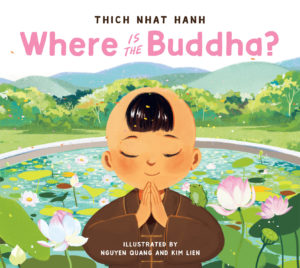In celebration of this release, editors Sister Trì Nghiêm of Magnolia Grove Monastery and associate publisher Jacob Surpin sat down and answered some questions around the Buddha’s true nature, lessons children can learn, and what makes this book different from previous children’s books by Thich Nhat Hanh.
Where Is The Buddha? is a beautifully illustrated children’s book that teaches young children about the Buddha’s true nature. What are some of the essential Buddha qualities that children are encouraged to recognize?
Sister Trì Nghiêm: The main message of this story is that we all have a Buddha, or Buddha nature, within us. The Buddha is not a god or something outside of ourselves but can be found in our own hearts. Everyone has the capacity to be kind, understanding, and compassionate. We can all cultivate peace, kindness, and love in our hearts, and learn to care about and live in harmony with others. These are essential qualities for happiness.
How can children learn to cultivate these qualities within themselves?
Sister Trì Nghiêm: When we know we all have these qualities deep within us, they are easier to find and cultivate. With help and guidance, we can learn to have more compassion for ourselves and for other people. We can learn to see that others are just like us—we all need kindness, love, and understanding.
Some practices are offered at the end of the book to help children practice mindfulness of breathing and walking. With mindfulness, we can learn to be more peaceful in everything we do. We can learn to calm ourselves down when we are upset so that we do not react with anger or violence. We can learn to touch peace within ourselves, like the Buddha.
The Buddha is not a god or something outside of ourselves but can be found in our own hearts.
Sister Trì Nghiêm
How can parents of young children implement the lessons from Where Is The Buddha? into their daily lives?
Sister Trì Nghiêm: If you model the practice of mindfulness yourself— especially mindful breathing, sitting, and walking—and learn how to calm your strong emotions so you do not say or do things you will later regret, you offer your children a precious gift.
You may like to draw parallels with other inspirational spiritual teachers and help children see that the qualities they embody are actually within themselves. Everyone can be like Jesus, Mohammed, or the Buddha. Even those who are different to us or whom we find difficult have the seeds of kindness and love within them. We all have the capacity to be awake to the suffering and goodness within us, and in others. We are all capable of cultivating love, compassion, and understanding.
How is this book different from previous children’s books by Thich Nhat Hanh, such as Is Nothing Something? and A Pebble for Your Pocket?
Jacob Surpin: Is Nothing Something? is an illustrated book with a question and answer format, and A Pebble for Your Pocket is a chapter book—it isn’t illustrated. Where Is the Buddha? is based on one of the stories in A Pebble for Your Pocket, which we simplified a little bit and made more accessible for younger children, and it is a fully illustrated children’s book with a story, the first one from Thich Nhat Hanh in quite some time. It is amazing to see the illustrations from Nguyen Quang and Kim Lien bring the story to life.
You shared that Where Is the Buddha? is an adaptation from a story found in another Thich Nhat Hanh children’s book. What about the story and its message made it a good fit as a stand-alone book?
Jacob Surpin: I was in our office, staying late one evening and looking over our library, and sat down to read A Pebble for Your Pocket. “Who Is the Buddha?” is the very first story in the book, and as I read it, I was struck by the quality of Thay’s storytelling voice—it brings you right in. I could see the story unfolding before me, and picture it so well, like it was illustrated. And then the message, that the Buddha is within all of us, and that we all have the capacity to be Buddhas, seemed very simple and powerful. The next day I brought it up with the rest of our team and we approached the Plum Village monastic editorial team about the possibility of a picture book right away. I really hope children and parents are able to enjoy Minh’s story.
I hope this interview has you ready to discover the Buddha yourself. Be sure to pick up a copy, Where is the Buddha is out Now!
About the Author and Illustrators
Thich Nhat Hanh is one of the most revered and influential spiritual teachers in the world today. Born in Vietnam in 1926, he became a Zen Buddhist monk at the age of sixteen. Over seven decades of teaching, he has published more than 100 books, which have sold more than four million copies in the United States alone. Exiled from Vietnam in 1966 for promoting peace, his teachings on Buddhism as a path to social and political transformation are responsible for bringing the mindfulness movement to Western culture. He established the international Plum Village Community of Engaged Buddhism in France, now the largest Buddhist monastery in Europe, and the heart of a growing community of practice centers around the world. He lives in Hue in Central Vietnam.
Kim Lien and Nguyen Quang are Vietnamese illustrators who have collaborated on books published in a number of countries, often under the pen name “Kaa.” Their illustrations are influenced by the folk culture of Vietnam and Asia. They live in Vietnam.

